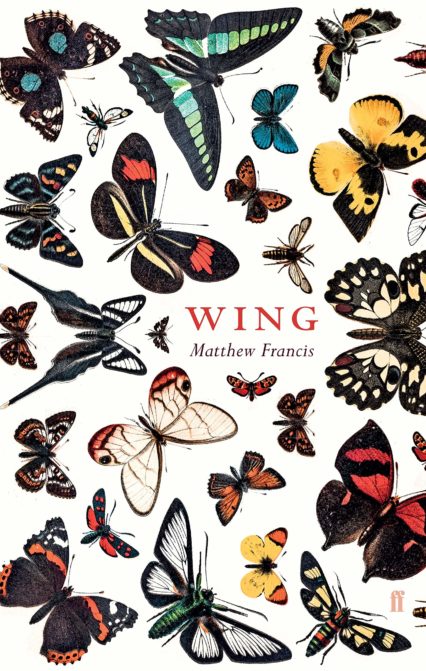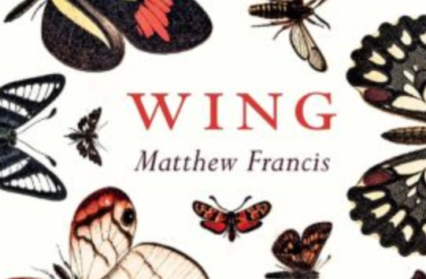Sophie Baggott reviews Matthew Francis’ seventh poetry collection, Wing, an introspective ‘labour of love’ about interactions with nature.
I distinctly recall my first encounter with Francis’ poetry. I was late to his work, having stumbled upon the poet’s sixth collection, The Mabinogi, among the piles of books scattered across the dim and dusty Soho room that Literary Review calls home. It was early summer in 2017 and, as the then-sprightly assistant, I was tasked with emailing the former Archbishop of Canterbury to arrange a review. A month later Rowan Williams deemed The Mabinogi a triumph of imagery that had been given space to “unfold and flower” – which leads me onto Francis’ latest collection, Wing, a book that has grown from intimate observation of natural elements.
 Wing is made up of three parts, each around eighteen pages and twelve poems long. Freefall is followed by Micrographia and finally Canticles. Some of the poems appear to have been evolving for a while; there are five-year-old audio recordings of Francis reading a few from Micrographia. It is fascinating to pick up the inflections and mutations, a word swapped here and there. Take ‘Nettle, Bee-Sting’, from Micrographia (after the scientific treatise by Robert Hooke, 1665). On the page, the spike-shaped poem opens: “You have been ambushed among the hedgerow’s foliage | by such a leaf” whereas, in Francis’ past recital, “softnesses” was in place of “foliage”.
Wing is made up of three parts, each around eighteen pages and twelve poems long. Freefall is followed by Micrographia and finally Canticles. Some of the poems appear to have been evolving for a while; there are five-year-old audio recordings of Francis reading a few from Micrographia. It is fascinating to pick up the inflections and mutations, a word swapped here and there. Take ‘Nettle, Bee-Sting’, from Micrographia (after the scientific treatise by Robert Hooke, 1665). On the page, the spike-shaped poem opens: “You have been ambushed among the hedgerow’s foliage | by such a leaf” whereas, in Francis’ past recital, “softnesses” was in place of “foliage”.
This hints at the degree to which Wing feels like a labour of love, a culmination of countless tender interactions with nature. At times the poems are deeply sensual, such as in the collection’s very first poem ‘Longhouse Autumn’ in which the writer is so attuned to his environment that he detects “A funny taste in the light, the copper tang of late afternoon.” The atmosphere is gentle and compassionate from the outset, where even a church is personified; the poet passes by as it is “tending its flock of gravestones”.
This first poem also proclaims a suggestion of Cymreictod through the “Cofiwch Dryweryn” graffiti that adorns a rock. Francis was born in 1956 in England, where he lived for more than four decades before taking up a lecturing post in Wales around the turn of the millennium. Wales only makes two more explicit appearances: a mention of “Welsh sheep fields” (‘Yellow’), and within the poem ‘Clock’ – a reimagining of poet Dafydd ap Gwilym being disturbed in his sleep, circa 1350. This is one that slots less neatly into the genre of nature poems. Dafydd is up to his usual tricks, of course, seeking out “a woman whose face he can never remember”.
This brings me onto a question that struck me again and again throughout this book: why are women so unmemorable, or indeed almost entirely absent? There’s regular name-dropping of male figures (John Barnie, Matsuo Bashō, Dafydd ap Gwilym, W. S. Graham, Max Ernst, Robert Hooke, Gustav Klimt, H. G. Wells, Charles Baudelaire…) and many male protagonists (even a fly is ‘he’), but a marked lack of women. Near the end we get a brief glimpse of a “brown Betty with toast in her hair” and with that she’s gone. The exclusion is striking.
More than once, we meet a lone writer – Francis? – typing in a remote landscape. For instance, here’s the penultimate stanza of ‘A Dream of Cornwall’:
A man is typing something in a cottage
by the pilchardy light of an oil lamp.
I am trying to read over his shoulder,
but the page is all consonants and obelisks,and I am miles away in my childhood.
An aura of retrospection seeps out of several poems. It’s as if Francis is not only angling the microscope on specimens – as he does often throughout the collection – but also looking down a more introspective lens. In ‘The Microscope’, he is back in College (the upper-case denoting his studies at Cambridge) peering into a microscope through which he sees “nothing in it but myself | and this morsel of nature… more complex than I had suspected. | Only the flaws in the lens | prevent my seeing deeper.” Francis also returns to College and companions of past years in ‘Freefall’, written in memory of a friend killed in a parachute accident: “he tickled the froth on his pint with the tip of a finger, | while outside the weeping willows were washing their tresses | in the still waters of the St John’s College punting pool.”
A very scholarly tone reigns in many of these poems; ‘A Charm for Earwigs’ quite literally required me to use a dictionary – “chitin stylus … poultice … pinna … malic”? The scientific jargon often feels inaccessible, and I definitely couldn’t get onboard with the ant-drowning, even in the name of science (“I dunked one in brandy. It struggled | till the air rose from its mouth | in pinprick bubbles”). Even so, Francis’ love of words is clear throughout, and this is given full play in the poem I liked best, ‘Collective’, which reimagines the collective nouns for birds – including a poltergeist of larks, a calligraphy of swallows, a pillage of seagulls.
Wing is a dense collection with some respite in pockets of beautiful imagery. One thing’s for sure: there’s no breezily winging one’s way through it.
Wing by Matthew Francis is published by Faber & Faber.
Sophie Baggott is a regular contributor to the Wales Arts Review.











